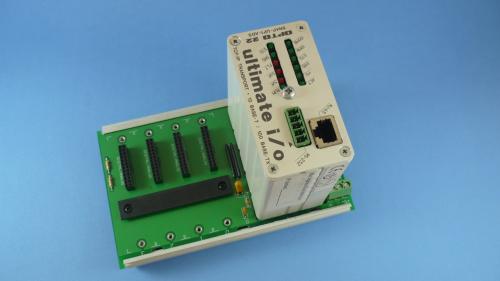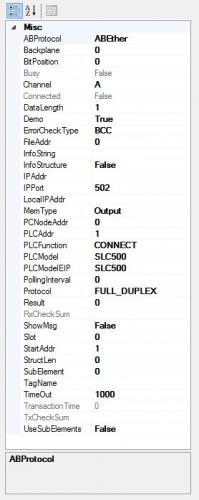Search the Community
Showing results for tags 'open protocol'.
Found 45 results
-
Hi guys, Do you have experience or know any good guides to set up a simulation case like this: - Simulating a PLC program such that the "PLC" is accessible on the Ethernet (for example just locally). - In addition, setting up the PLC settings with FINS protocol such that it is possible to write to the PLC with FINS protocol from another device. The first part is most important. Best regards PC_VS_PLC
- 2 replies
-
- cx-simulator
- omron
-
(and 5 more)
Tagged with:
-
Hi, I have a omron PLC in a FINS network. Should there be any problem connecting another PC to that network and ping the PLC? I somehow don't get any response when I try to ping the PLC from a PC. Best regards
-
Hi everyone, Can any one share me the sample source code for melsec(MC) protocol, as I am working on this protocol. Thank you in advance
-
Hi everyone Is SLMP protocol and MC protocol are same?? what is the difference between these two protocols?? Thank you in advance
-
Hello all, I'm using MC Protocol Format 4 to communicate with a VB6 application on a PC. I want to make some slight modifications, and I am getting a sum check error being returned by the module to my application. I believe (haha) I am calculating the sum check code correctly for Format 4 as most commands do work (reading for example). I was wondering if anyone knew of the buffer memory location on the QJ71C24N card that stores what the card is calculating for the sum check? This way I can have a troubleshooting tool to see what I am calculating wrong. I have looked through the manuals (application/basic) for the C24 already as well as the Melsec Reference Protocol manual. I have attached the error code for reference, again, I am only looking for what the C24 calculates as the sum check code. Thanks
-
Hello! Anyone here know about Fuji Electric power monitoring unit F-MPC04? Does anyone have the Communication Manual for this unit? I need to find the F-MPC Protocol which it used with RS-485. I know it is accessible via MODBUS RTU, but there is already a system exist using this F-MPC protocol. It seems Fuji doesn't publish this protocol for public, but there should be a document somewhere :D If anyone knows please kindly reply here. Thank you
-

[Manuals, Tutorials] - Q_L MELSEC Comms (MC) sh080008l.pdf
kaare_t posted a topic in Download Comments
Q_L MELSEC Comms (MC) sh080008l.pdf View File MC Communication Protocol Submitter kaare_t Submitted 06/14/16 Category Manuals, Tutorials -
-

Disable BOOTP on built in ethernet port
GeraldTech posted a topic in Allen Bradley / Rockwell Automation
It's another BOOTP post! I know you're all as excited as I am, so lets get started. But seriously, I'm trying to disable BOOTP on the built in Ethernet ports, not on an Ethernet module. I specifically say disable because BOOTP successfully assigns the IP address to my Compact Logix, however I still need to disable BOOTP to make it a static IP address rather than a dynamic IP address. I'm going to list everything that I have tried, so that anyone with the same issue can have an all-in-one-place reference. (Because there's a number of forum posts and other information for this topic on the internet, with many different suggestions) If I see different ideas/suggestions in other places, I can edit them into this post. Things I have tried: (and you should try if you have this issue) Disabling all firewalls, (For me: Windows/Avast) Disabling all other network adaptors. (Wifi especially, but any and all adaptors you are not using for the setup) Using a different laptop/operating system: (My current laptop runs windows 8.1 and uses a Linksys usb to Ethernet device to talk to the PLC, I tried a laptop running windows 7 which communicated using a built in Ethernet port) Lastly: Try to use all available methods to disable it. For me, that would be: BOOTP standalone server, RSLinx, (Trying to use both USB and Ethernet connections) and finally RSLogix. (Actually, only Ethernet modules have a "disable BOOTP" checkbox built into RSLogix, so that is not an option for me.) [If you have an Ethernet module, go to port configuration in RSLogix and uncheck the "enable BOOTP" checkbox] Anyway, RSLinx Classic (version 3.71) and BOOTP Standalone server (version 2.32) are each coming back with an error when I try to disable BOOTP. I'll attach a .jpg of some screenshots, and some Wireshark save files to show what I mean. In the RSLinx Wireshark file, it shows a "privilege violation" packet being sent from the PLC to the laptop towards the end of the exchange, but I'm not sure what privileges the laptop needs/doesn't have. For the wireshark files: I cleared everything happening before I try to send the command, so that there isn't a ton to search through. As far as timing of the wireshark files go: I start recording traffic, send the disable command (by clicking the disable BOOTP/DHCP button on BOOTP server or "apply" on RSLinx) then I stop recording traffic once I get the error message. So, the captured packets should be just the attempt to disable BOOTP and that's about it. I am sorry that I the pictures are strung together using paint, but I don't have photoshop on my work computer so it's the best I have. Any suggestions/help would be appreciated! (Regardless of whether they are suggestions for me, or suggestions that I may have missed intended for anyone with this problem.) Thank you for your time. Edit: I had the attached pictures open in paint/photo viewer, sorry that they look bad in the forum picture viewer. BOOTP_wireshark.pcapng rs_linx_USB_wireshark.pcapng rs_linx_wireshark.pcapng- 10 replies
-
- bootp
- bootstrap protocol
-
(and 3 more)
Tagged with:
-

Video Game running in an Opto22 PAC using RFB protocol and VNC
Absolutelyautomation posted a file in Other PLC Demo Software
-

[Other PLC Demo Software] - Video Game running in an Opto22 PAC using RFB protocol and VNC
Absolutelyautomation posted a topic in Download Comments
View File Video Game running in an Opto22 PAC using RFB protocol and VNC Video game application running in an Opto22 PAC using RFB protocol and VNC client as interface, can be played with the Free simulator PAC Sim Submitter Absolutelyautomation Submitted 04/01/16 Category Other PLC Demo Software -

EATON Cutler-hammer Incom protocol forImpacc systems for HMI/SCADA
Scadadoctor posted a file in Other PLC Demo Software
Version 1.0.0
2 downloads
The Eaton cutler Hammer Incomprotocol for Impass systems driver from Parijat (ParImpacc), supports communication through serial or Ethernet ports to Eaton Cutler-Hammer devices using Incom or Impacc protocols, as a Master format. The driver enables users to capitalize on the low cost of communications equipment for use as the backbone for a power monitoring system and power quality analysis. ParImpacc can communicate with any serial via MINT or Ethernet viaEMINT device (Master Industrial Communications Network Translator), equipment as breakers, digital meters or motor overload relays. It supports communication with MPCV, IQ 200 & other Eaton devices. The IMPACC protocol module is designed to communicate with devices that use the ASCII version of the INCOM protocol to communicate with a host. Features : Host-to-RTU commands supported: 2024 -300 Get Fast Status 2025 - 305 Get Current Buffer 2026 - 308 Get Power Buffer 1 2027 - 309 Get Power Buffer 2 2028 - 30F (00003B) Get phasingVoltage 2029 3A4 Get INCOM Statistics 2030 3C8 Get Flags Buffer 2031 3C9 Get Setpoints This driver can be conviniently used with Visual Studio in development of complete large scale complex HMI/SCADA Systems. It can be used to perform advanced reporting MES, analytics, IoT, Big data type apps. One example is available to download here For More Info Overview of Parijat Drivers: Click here Additional supporting Info about Parijat Drivers:Click here Complete Related Driver options: Click here -

[Other PLC Demo Software] - EATON Cutler-hammer Incom protocol forImpacc systems for HMI/SCADA
Scadadoctor posted a topic in Download Comments
View File EATON Cutler-hammer Incom protocol forImpacc systems for HMI/SCADA The Eaton cutler Hammer Incomprotocol for Impass systems driver from Parijat (ParImpacc), supports communication through serial or Ethernet ports to Eaton Cutler-Hammer devices using Incom or Impacc protocols, as a Master format. The driver enables users to capitalize on the low cost of communications equipment for use as the backbone for a power monitoring system and power quality analysis. ParImpacc can communicate with any serial via MINT or Ethernet viaEMINT device (Master Industrial Communications Network Translator), equipment as breakers, digital meters or motor overload relays. It supports communication with MPCV, IQ 200 & other Eaton devices. The IMPACC protocol module is designed to communicate with devices that use the ASCII version of the INCOM protocol to communicate with a host. Features : Host-to-RTU commands supported: 2024 -300 Get Fast Status 2025 - 305 Get Current Buffer 2026 - 308 Get Power Buffer 1 2027 - 309 Get Power Buffer 2 2028 - 30F (00003B) Get phasingVoltage 2029 3A4 Get INCOM Statistics 2030 3C8 Get Flags Buffer 2031 3C9 Get Setpoints This driver can be conviniently used with Visual Studio in development of complete large scale complex HMI/SCADA Systems. It can be used to perform advanced reporting MES, analytics, IoT, Big data type apps. One example is available to download here For More Info Overview of Parijat Drivers: Click here Additional supporting Info about Parijat Drivers:Click here Complete Related Driver options: Click here Submitter Scadadoctor Submitted 03/10/16 Category Other PLC Demo Software -

Rockwell/Allen Bradley ethernet communication Protocol/driver
Scadadoctor posted a file in Demo Software
Version 1.0.0
224 downloads
The Allen-Bradley Ethernet Driver provides an easy and reliable way to connect Allen-Bradley Ethernet devices to Client applications, including HMI, SCADA, Historian, MES, ERP and countless custom applications. This driver supports the Allen Bradley SLC 5/05 series, PLC-5 series, ControlLogix, CompactLogix, and MicroLogix PLCs. Features Interface: TCP/IP Ethernet Port, DHRIO, Net-ENI PLC Supported: AB Controllogix, Compactlogix, Micrologix, SLC50x, PLC5, via TCP/IP Ethernet built-in or Module port. Any device with Ethernet/IP protocol. Methods: Open, Close, RefreshInfo, ClearDataBuffer Events: OutCome (fires when a communication transaction completes) , RXComplete, TXComplete General: Also Supports unsolicited messages from SLC, Clogix family. Via DHRIO, access SLC & PLC5 data tables for read/write. Read or write most of the AB data types. support for DataQueue reads in SLC and Micrologix Throughput: Reads 100 consecutive registers @ 10Mhz in 40 msec. This driver can be conviniently used with Visual Studio in development of complete large scale complex HMI/SCADA Systems. It can be used to perform advanced reporting MES, analytics, IoT, Big data type apps. One example is available to download here-
- allen bradley
- rockwell
- (and 4 more)
-

[Demo Software] - Rockwell/Allen Bradley ethernet communication Protocol/driver
Scadadoctor posted a topic in Download Comments
View File Rockwell/Allen Bradley ethernet communication Protocol/driver The Allen-Bradley Ethernet Driver provides an easy and reliable way to connect Allen-Bradley Ethernet devices to Client applications, including HMI, SCADA, Historian, MES, ERP and countless custom applications. This driver supports the Allen Bradley SLC 5/05 series, PLC-5 series, ControlLogix, CompactLogix, and MicroLogix PLCs. Features Interface: TCP/IP Ethernet Port, DHRIO, Net-ENI PLC Supported: AB Controllogix, Compactlogix, Micrologix, SLC50x, PLC5, via TCP/IP Ethernet built-in or Module port. Any device with Ethernet/IP protocol. Methods: Open, Close, RefreshInfo, ClearDataBuffer Events: OutCome (fires when a communication transaction completes) , RXComplete, TXComplete General: Also Supports unsolicited messages from SLC, Clogix family. Via DHRIO, access SLC & PLC5 data tables for read/write. Read or write most of the AB data types. support for DataQueue reads in SLC and Micrologix Throughput: Reads 100 consecutive registers @ 10Mhz in 40 msec. This driver can be conviniently used with Visual Studio in development of complete large scale complex HMI/SCADA Systems. It can be used to perform advanced reporting MES, analytics, IoT, Big data type apps. One example is available to download here Submitter Scadadoctor Submitted 02/28/16 Category Demo Software-
- allen bradley
- rockwell
- (and 4 more)
-
I would like to bring up a topic that I've been been bouncing around in my head for the past few months. I make a living as an industrial programmer, sequencing using PLCs, dealing with drives, networking, controlling heavy machinery. All the hardware we use are from established companies like Allen Bradly, Sick, Cognex, Delta, ABB, etc... big $$$, you pay for the software, pay for the hardware and pay for the support. It's not uncommon for a large control system to cost $50k+ (hardware only) By night I'm just your regular maker. Programming AVR series uC, ARM series, playing with various open source hardware Arduino, RPI, Teensy, 3D printers, designing PCBs, stepper motors... whatever I can get my hands on. Both worlds are the same... but completely different, and there is ZERO overlap. I'm interested in why other people think this is, I'm sure that makers don't get into the industrial stuff because the price point. I'm not going to pay 8k for a AB Logix rack... are you kidding me? but vice versa? is the lack of support really all that daunting? I find OS stuff to be way more powerful, understanding something from the bare metal is the most amazing feeling, and being able to modify it to your needs is even better. Digging into somethings source is without an argument the most flexible platform to build on, and knowing the board level schematic for a chuck of hardware opens up a world of opportunities... Then lies the ethical dilemma... If I was to profit off other people's work, does this make me a bad person? What if I push the changes back into the development (which frankly I have no problem doing) I would love to head other people's opinions...
- 1 reply
-
- Automation
- open source
-
(and 5 more)
Tagged with:
-
Hi, I am working on the following setup: External server connecting to PLC system via QJ71E71-100 Ethernet module and using MC protocolConnection via LAN cable (straight-though) between external server and QJ71E71-100 Ethernet moduleGoal is to pull data from PLC system via the use of MC protocol + 4E frame + ASCII data code + batch read Word units (via 0401 command, which is part of MC protocol)External server will act as TCP client, while QJ71E71-100 Ethernet module should act as TCP serverThe external server is using custom software (programmed in Python) to query/process response. At this moment I can 1) "ping" the QJ71E71-100 Ethernet module successfully, 2) connect to it via TCP socket and 3) send data via TCP socket. All is working well so far BUT I am not getting any data back from QJ71E71-100 Ethernet module. My setting are as follows: IP address of external server = 192.168.1.203 (it binds the socket to port 1500 of this external server when initiating communication). The external server will always initiate communication to query data whenever needed, FYI. IP address of QJ71E71-100 Ethernet module = 192.168.1.254, and it connects to port = 1500The Ethernet diagnostic tool indicates that my TCP packets are being received ("Total Number of Receives" increase every time data is sent), and that TCP response packets are being sent (increases in tandem with "Total Number of Receives" (apologies for poor picture quality): Would someone in the forum have experienced a similar issue (meaning that you could connect + send data from external server, but no data was getting sent back from QJ71E71-100 Ethernet module to external server? Are there some obvious mistakes in the configurations to the experienced eyes in this forum? For your information I am not using any gateway for the connection: it's a straight-through LAN cable from the external server directly into the QJ71E71-100 Ethernet module. Would such a setup work out of the box, or do I need to configure "Router Relay" or "Station No <-> IP information" within GX developer? Lastly I have not configured FTP, email or Interrupt settings, FYI. Thank you for your help, feel lost with this TCP connection issue. Regards to all forum readers! PS: find attached the pictures detailing configuration settings for both QJ71E71-100 Ethernet module and external server.
- 2 replies
-
- MC protocol
- QJ71E71-100
-
(and 4 more)
Tagged with:
-
Hello, I am not familiar with the Omron PLC's. A PC is connected to the peripheral port of an CJ1M CPU12 PLC. The write command the PC is transmitting to the PLC looks like this (ASCII): "@00WD0070010055*." Can you tell me what kind of communication protocol it is using? It is a public or proprietary protocol? Thank you!
-

Open-Source Ethernet/IP communication stack
flylikechris posted a topic in Allen Bradley / Rockwell Automation
Hi guys, I've found the following website: http://www.rockwellautomation.com/rockwellautomation_de/news/news-detail.page?reqid=1356918 It shows a download link for some reference material regarding Ethernet/IP communication drivers. I've been lucky with Mitsubishi and Siemens supporting TCP/IP, but for some reason this is just now starting to be supported by Rockwell, and many of the budget controllers do not yet support TCP/IP (at least without an interface module, and even then they are only compatible with certain processors). I would love to write my own Ethernet/IP driver for communicating with Rockwell controllers and I/O blocks. This looks like the perfect starting point as Rockwell claims to support it. I've got an email out to the representative listed in the article, and have talked to rockwell engineers over the phone, but do not yet have any leads. I thought I would post here in case anyone has used this, and could provide some information on where to get the reference material. I imagine there are many tinkerers on here who get excited by these things . I did notice this repository that looks close: https://github.com/EIPStackGroup/OpENer The library is called "OpENer", and the original expired download link in the rockwell press release is "Opener.Sourceforge", so maybe there is a correlation. Maybe this github library is the latest iteration of the project files released in 2009. (The github library looks very reliable, and professionally supported). Any leads on here would be greatly appreciated. If I can prove this concept to work, I will likely go further with odva certification. But for now this will be fun to reverse engineer and prove. Also, if I get any leads on this I will make sure to post back. -







